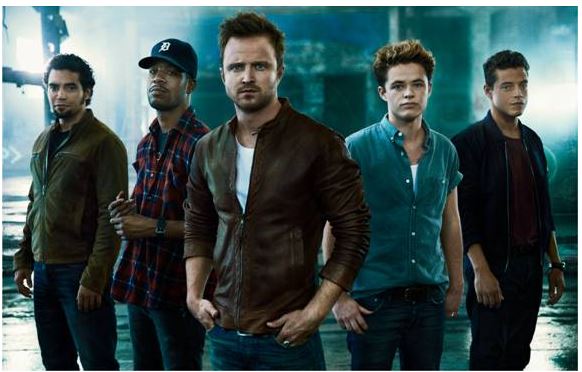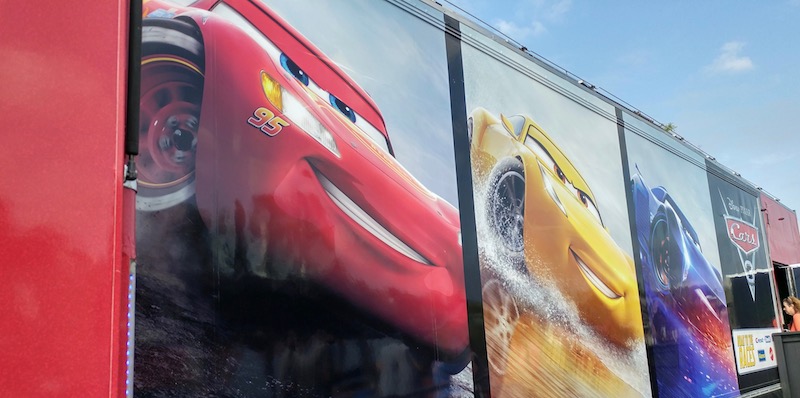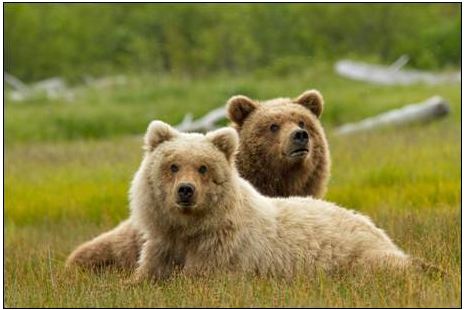Disclosure: I attended this interview as part of an all expense paid trip on behalf of Disney. All opinions are completely my own.
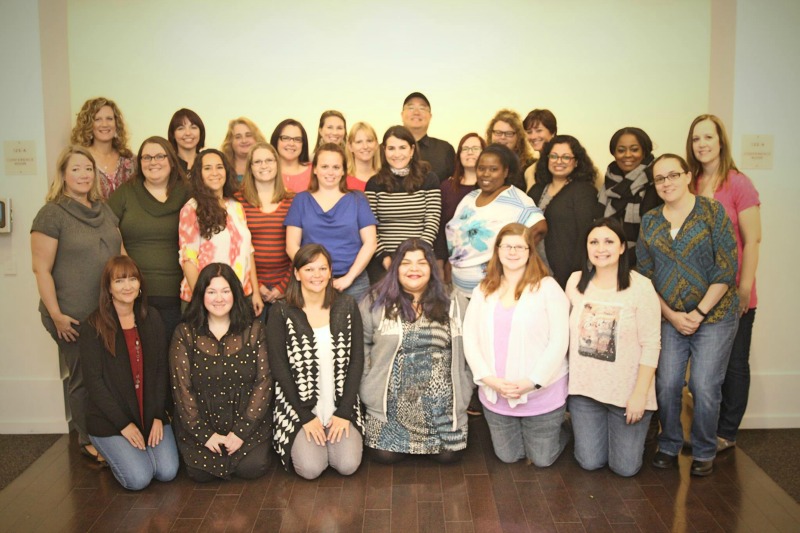
Interview with The Good Dinosaur Director Peter Sohn & Producer Denise Ream
The Good Dinosaur opens tomorrow, November 25th, and I can tell you that the imagery is absolutely stunning. You’ll get my full movie review tomorrow, but right now I’m going to be sharing with you my interview with Director Peter Sohn and Producer Denise Ream.
We had the chance to meet up with Peter Sohn and Denise Ream at Disney Studios last week. I have to say I was incredibly impressed with how humble Peter Sohn was during the interview. He has so much talent, but seemed reluctant to accept the praise. He said that Denise surrounded him with experienced people that helped. See what I mean? Incredibly humble.
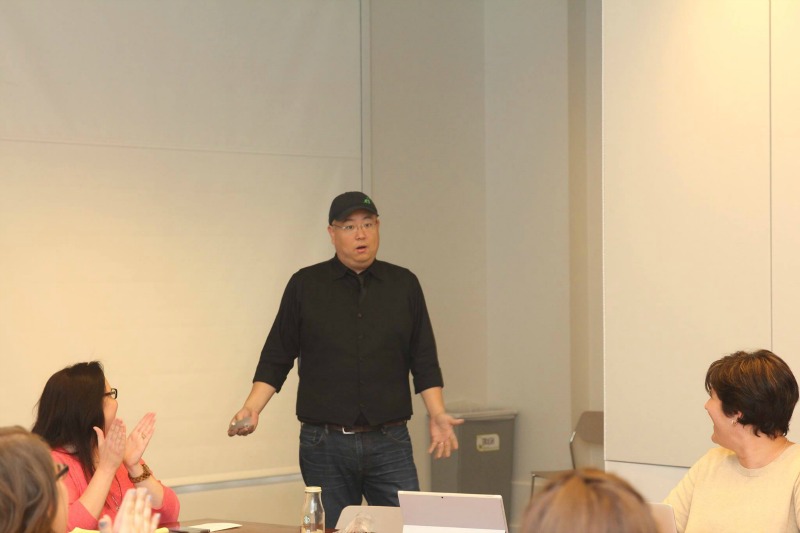
Some of my favorite questions and answers from our interview.
You have done lots of jobs at Pixar (i.e. story-boarding, voices, and now director). What led you to directing this time?
What’s interesting was this show was pitched by original director Bob Peterson in 2009 and then he asked me to come help develop the project. During the development I was doing story and designs for him and then he asked me to be his co-director. From that we were trying to wrestle the story and it was tough. A lot of these Pixar films go through that kind of place where you put every answer and you go in every direction. We had the boy and the dog story. We had a father-son story. We had a trying to change community story and then […] it was hard to kind of end it all.
They asked me to become the director from there because I had known all the paths that we have gone through and I basically, simplified it to Bob’s original pitch. I love Bob and he’s a great friend and I just loved that original idea. It was really Bob who got me developing into that co-director position. To your point, I learned a lot from working with the other departments, too. That’s nothing like the directly job. There’s so much I didn’t know.
I was scared and Denise Ream, our producer, surrounded me with a lot of experienced people to help out with that. Everyone was just like ‘Here’s our hearts. Let’s do it.” – Peter Sohn
The realism in the animation is mind blowing. It’s amazing. Was there any special technology or animation advancement that was used?
It’s not new technology, but we ended up basically using Google maps to create a lot of the locations. It’s called USGS topological survey maps. We started with that and got us a long ways [toward] getting the big scope that we wanted. Then the trick was populating that terrain with the trees that we had modeled, the leaves, the mulch, the rocks, all of the vegetation.
That was a special tool that we wrote. This was the first time we used 3-D clouds, what we call volumetric clouds throughout the entire film. Usually we map paint our clouds. We did a lot of water shots. Again, it’s not new technology but we did many, many more water shots than we’ve typically done in a Pixar movie. In terms of the actual process we just had a slightly different workflow process for the animators.
When you’re under the gun to get the show done, you dole out shots individually and instead we gave each animator a run of shots that we felt would make a more consistent performance. That was a very different workflow for the animation department and they actually really, really loved it. -Denise Ream
All of it was in service to the story. We did a lot of research. Denise, when we started this project, she took us out. She said let’s go get lost. I’m from New York where we would go into the wilderness and The Rockies and I had never been before. So, going out there it was just so dang gorgeous. Horizon lines in New York was [from] McDonald’s to Subway and then going out there it was just so awe inspiring that you could go from there and see 500 miles down that way [to the left] and see the other 500 miles down that way [to the right].
It was just full of clouds and it went forever and it was so soul enriching. It is something we wanted to capture. That’s why all this technology was just like, if we want to do that we have to do this. -Peter Sohn
Because originally the story took place in a different part of the country. It wasn’t really our intention to set up where we did. But then we got there and we thought, it makes so much sense because that’s where you find dinosaur bones and it was very inspirational to use. -Denise Ream
[Tweet “”This is the first time we used 3-D clouds…throughout the entire film.” Denise Ream #GoodDinoEvent “]
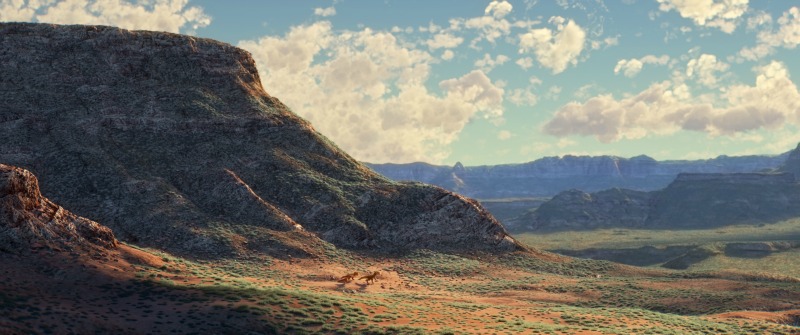
Once you decided it was going to be set in the West, is that when you decided to bring in a lot of the Western elements?
It started off with the idea of doing a frontier story, but where we would do it was just a little like it could’ve been in the south. A Southwest kind of look, even though Monument Valley is in Utah but there was that kind of thing. I grew up on Westerns and all I did was watch these movies. Shane was one of my favorite movies and in the opening of that film was this farm in front of the Teton Valley. It was the Grand Tetons and I was like let’s go there. That’s where we started everything.
Then it was lucky that there was a Snake River that went through there that we were like oh, my goodness, this is exactly what we need for this story. The whole idea when you go out there all you ever think about is how did people survive out here? How did they get across these mountains with nothing? How did they do that? And you know, like growing up in New York my dad had a grocery store and it was a small family. All of usin this little grocery store trying to survive in a city. All the research that we would do in meeting farmers and ranchers out there it it me so hard that these were the same types of families surviving but on thousands of acres each member of that family was an integral part for the survival of that thing.
And so it was a universal thing all of a sudden like, oh, my God I totally connected. Look at these people. They’re living in love and working together and up here in this really beautiful yet tough landscape. So it was really inspiring for us to try and say you know what, let’s have our little dinosaur, be a part of this family and he already feels like– I can’t contribute. I want to. Everyone has to do something for the survival of the family. And so a lot of the Western movies are about survival and when we first started doing this story board it became a cliché.
The first version of this movie was literally Sheriff, let’s go into a saloon and find us a Lunasaur or whatever it was. And then you know, it just felt like we were making fun of it. And then once we started meeting the family and doing the research and all these people out there it was just no, I want to honor this. I’m American and born in this country. I love that people fought to live through this and so it’s, it was something that you know–.
Yeah, the McKay’s, this ranching family that we met in Oregon. When we first started with the original, I mean when we re-started the version of this film that was so much like a parody, we had these T-rexes but they were like cowhands and it was JR, JW and JL, you know. And it was so silly. And they were like ding, dang and it was like just a big cliché. They were kind of running with coconut noises. And when we watched them we were like what am I doing? This is like such — we’re just making fun of it. I hate this. And then when we went to do some research we met this family, the McKay’s, and they have a ranch, a large ranch out in Oregon, right on the border of Idaho and Oregon. And it’s this really unique family. There is the mom and dad, both white and then they adopted five black Haitian kids. And so when you get there it was like whoa, this is like a whole unique kind of family here. But they would change my life. The way that family lived in love really blew me away.
And I’ve realized as a parent how much of like a helicopter parent I am with my kids where I’m oh, you can’t do it? Let me do that for you. Let me help you. Oh, I’m so sorry. I’ll help you. And dad was just like I’m going to tell you this once and you’re going to learn to do it, all right. He treated us like he would treat his children and I was so blown away — and it was all love. When you shake his hand, my hands are like marshmallows. This guy’s hand was like a tree and he would just like tell you how to do everything.
But oh boy, I can’t tell you how much that inspiration of that family was where we were like you know what, I want to honor — let’s not make them clowns. Let’s make them a family. And it’ll also parallel what Arlo’s family is going through. It’ll help Arlo’s journey. -Peter Sohn
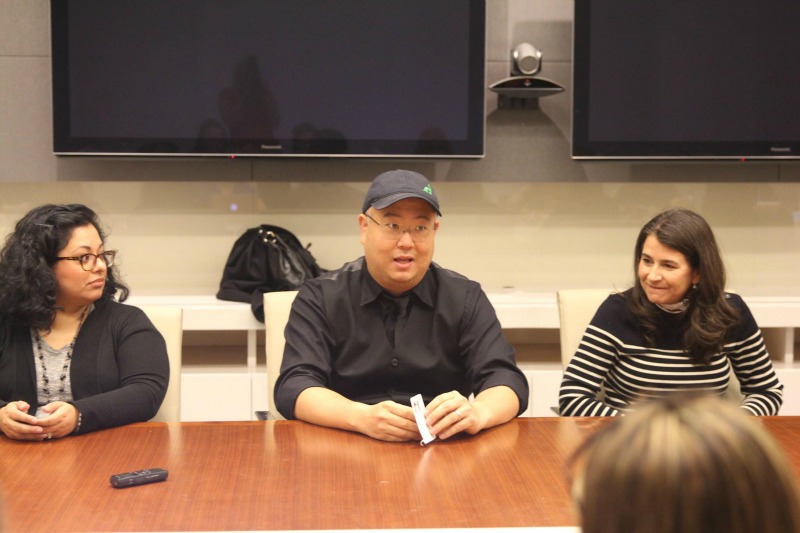
We have had an opportunity to meet the young men who voiced Arlo, Spot and Buck. They were also very complementary of the direction you provided them. They said was very inspiring to them.
Oh, that’s very nice. I love those guys. What’s funny is that I do scratch voice at work. I do a lot of temporary voices and I’d been through all the directors at Pixar and how they kind of direct you. Sometimes it can be tough because you’re just, the line is elbow macaroni. Elbow macaroni. Do it again like this. Elbow macaroni. And then you go elbow macaroni. No, no, like this, elbow macaroni. Okay, elbow macaroni. No, no, you’re not listening to me. Elbow macaroni. [Every time he said elbow macaroni in the example, it sounded exactly the same!]
And then like on the 15th take you’re like I don’t know what you’re looking for. Or some other directors are like imagine that you are, you had cereal and then like the milk is all the way up to the top of the bowl and you have to carry it like this and make noises would you make. And you’re like oh, I don’t want to spill you know, and so every director has their tools. And I learned a lot from that. And so when I’m getting to work with these kids it was always you know what, I’ve been in those shoes. This is all going to be about trust. If we don’t get through the lines don’t worry about it you know. We’ll have some fun and whatever– and very observant.
And sometimes you have to be very emotional and I would be uncomfortable if I’m in front of you guys and I’m like okay you have to cry now in this scene. And then sometimes we’re let’s turn out the lights, don’t worry about it. It’s always just try to find a secure place where you can be vulnerable. Those kids are such pros. They were so amazing, all of them. -Peter Sohn
[Tweet “”Those kids are such pros. They were so amazing, all of them.” @PEETSOWN #GoodDinoEvent “]
You use the word trust a lot. You gave them a lot of trust.
Yeah, well, I did. I really trusted them. -Peter Sohn
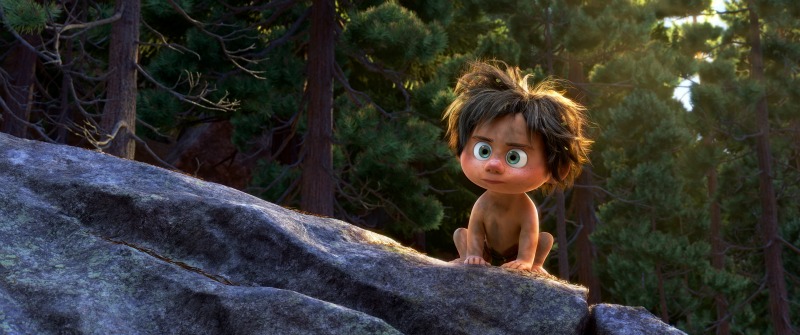
What type of direction did you give them specifically with Spot?
Yeah, there were two different things. Spot was mainly painting the situation for him and explaining that there were rules to Spot’s world where we didn’t want to go into kind of a primate world because there was Tarzan and there was all that kind of stuff. We really wanted to stay in this kind of canine world. I would just say like you come as a character that’s brave, strong and tenacious and you know, Jack, I already know you are like that.
But, as we grow we’re going to kind of take some of the layers away and find, the little boy that Spot is and then he would understand that. And then it would be basically okay, we’re in the woods. It’s raining. You’ve just pulled some animal out of the woods and I need some breathing down so let’s get into it. And so it’s just about painting a picture with Spot until we got to the emotional places. With Jack he would always be okay, let’s start, like you howl now, you’re teaching or learning how to mourn and it’s almost like you’re telling your buddy you know, it’s okay. Can you give me a mourn or howl like that? And then we’d play and experiment with that.
But with Raymond he can get into emotions so fast. You know, you paint the picture then you sit with him and you go okay, Raymond — and you would save some of the emotional stuff for in the middle because if you save it for the end of his voice would be tired but if you go to early then you may not be able to get to the emotion real quick. So you would do some fun stuff in the beginning and then let the story play out until we get to the mid part.
And then once we hit this one, I’ll start painting the picture again and then feel where Raymond’s at but Raymond would go okay, I’ve got it. Let’s do it. I’m like okay, are you sure you’re in this thing right now? [Removed Possible Spoiler]
Each performance it’s so different and so you’re just listening to what did they like or you know jumping around. Like Jack is such a sports guy and so you’re like what was the last game man? What did you do? – Peter Sohn
You’ve done a lot of voice work yourself and in this film you got to be The Collector which is hilarious. Give us a little bit of background on doing your voice work and why did you choose that character?
I didn’t choose it really. – Peter
It was funny, first when we were developing that sequence, like Pete said, we end up using a lot of people at Pixar to do the scratch voices that we used to cut the scenes against. And I was like Pete, we don’t have time to go audition for this so you’re going to have to do it. And–. -Denise
And I was like, we’ll find an actor. We’re going to find a real actor–. -Peter
Yeah, you didn’t even want to do scratch. -Denise
Oh right, right, that’s right. -Peter
Right, you were really reluctant to that. I was like Pete, please we don’t have time. And then you did the scratch and then we were just working on the scene. But then when Pete pitched the scene to John Lasseter, John was like you’re going to be the pet collector. He was like no, no, no I really want to go and get an actor. You’re going to be The Pet Collector. And so then John actually ended up directing the scene, which I thought was really fun. -Denise
Yeah, and he would push because he’s just like lower your voice. And you’re like okay, lower [LAUGHTER]. Lower it here. Okay. And then just keep low. Okay, now say that. And then he would go lower, lower. And I’m like I can’t, I can’t get lower than that. But yeah, yeah it was really fun. I had never been directed by John. -Peter
That was the one director that hasn’t directed you… That was a voice you kind of, was a character from Cal Arts right? -Denise
Yes, that’s right. This is so silly. But in a school I made this thing with a friend – a fake Moosehead and it was all because of Disneyland. Do you remember the country bear? We’d have those talking guys that would say like hey doofus or whatever it was.
I had a little guy up there [on the wall] that I had a tape recorder that would loop and so every 15 minutes I would say you smell like McDonald’s. And the next 15 minutes later, I can see you. So that I could find a test machine so when you’re flipping and you’re shooting something you would hear this head every 15 minutes go, can you see me? Where is that coming from? It was so silly. -Peter
There is talk about another The Good Dinosaur film, but nothing concrete. Peter Sohn said that they only finished this film a few weeks ago. Seriously, a few weeks! It was such a fun interview with both Director Peter Sohn and Producer Denise Ream. I especially liked the parts when Peter was speaking about working with the younger actors and helping them get their parts. I appreciate the fact that this movie took a lot of hard work, but that there was so much heart behind the making of it.
Looking for The Good Dinosaur products and toys? Get them here.
THE GOOD DINOSAUR on Social Media
Facebook | Twitter | Instagram | Pinterest | Website
Disney/Pixar on Social Media

